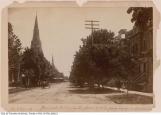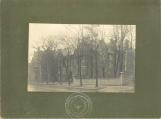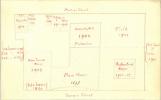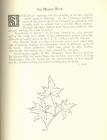1
Havergal Hall: A Church of England Ladies' CollegeThe founders of Havergal Hall, as it was originally known, were attempting to fill a pedagogical vacuum in the growing city of Toronto. While The Bishop Strachan School (nearby on College Street) had been offering girls education since 1867, it had a 'High Church/Trinity College' affiliation (a more 'formal' Anglican stream). In contrast, the first Havergal board, including Samuel Blake, George Wrong, and Herbert Mason, were 'Low Church/Wycliffe College' supporters (more evangelical in nature).
Many of the board had already been involved in the founding of the boys' school Bishop Ridley College in St Catharines in 1889. In choosing the British female hymn writer Frances Ridley Havergal (1836-79) as inspiration for the new school's name, they solidified this connection.
A piece in the 1894 Evangelical Churchman sums up their thinking - and their choice of urban location:
"Many members of the Church of England in Toronto and throughout the Dominion have, for a long time, been convinced of the importance of uniting Evangelical spiritual influences with a thorough intellectual cultural ... It is now intended to take a further step, by establishing a School for Girls. ... Although there are already established in Toronto schools for girls that are doing excellent work, yet it is felt that there is still room for one in a part of the city at some distance from the other large schools. ... Havergal Hall is thus in one of the pleasantest and most important residential quarters of the city."
2
Havergal Hall Pamphlet, 1894: announcing a new Toronto girls' school1894
Jarvis Street, Toronto, Ontario, Canada
 Credits:
Credits:Dr. Catherine Steele 1928 Archives, Havergal College
3
Life on Jarvis Street: A Student's PerspectiveIn the 1908 yearbook, Havergal student Ursula Wilton waxed poetic about life on Jarvis Street. The church to which she refers is St Paul's on Bloor Street East (just west of Jarvis Street).
We go to church up Jarvis Street,
With escort staid;
A most agreeable sight, in all
Our best arrayed.
Sometimes we put our books away
For all the call to church obey;
Folks stare, who meet
That long, long line, proceeding slow,
Sober, discreet;
Imposingly we take a walk
On Jarvis Street.
We know the sights of Jarvis Street
Extremely well;
The urchins whom our Mistress stern
Must quell.
The barking dogs, the mansions grand,
The drug store and the peanut stand,
The gardens neat.
Sometimes we gaze, sometimes our tasks
Instead repeat;
It matters not; we take a walk
On Jarvis Street.
4
Photo of 350 Jarvis: Original site of Havergal College1894
Jarvis Street, Toronto, Ontario, Canada
 Credits:
Credits:Dr. Catherine Steele 1928 Archives, Havergal College
5
Jarvis Street looking south towards Carlton Street1885-1895
Jarvis Street, Toronto, Ontario, Canada
 Credits:
Credits:City of Toronto Archives, Fonds 1478
6
Photo of 354 Jarvis Street (the 'Main School')1906-1916
Jarvis Street, Toronto, Ontario, Canada
 Credits:
Credits:Dr. Catherine Steele 1928 Archives, Havergal College
7
The Most Modern of ConveniencesThe new 'Main School' built in 1898 at 354 Jarvis Street spared no expense. Author Mary Byers, in 'Havergal Celebrating a Century' (1994) describes the structure:
"It had a duly impressive and spacious entrance hall with an open fireplace. The first floor housed drawing rooms, sitting rooms, the principal's study, classrooms, and a small assembly hall. The second floor contained a sitting room, double bedrooms, and cubicles ...The third floor combined more bedrooms, a large studio, a laboratory, and eight piano rooms ... The maids' quarters were on the fourth floor ...The prospectus boasted 'every modern convenience in the way of heating, ventilation, bells, speaking-tubes, electric lighting, etc.' and grounds that had 'been laid out as tennis lawns.'"
The school no doubt proved a stark contrast to the city's poorerest neighbourhoods such as nearby St John's Ward (bounded by Yonge Street, University Avenue, Bloor Street and Queen Street).
8
'Northfield House' (the Rutherford estate)Circa 1900
Jarvis Street, Toronto, Ontario, Canada
 Credits:
Credits:Dr. Catherine Steele 1928 Archives, Havergal College
9
Map of Jarvis Street campus and integrated buildingsCirca 1913
Jarvis Street, Toronto, Ontario, Canada
 Credits:
Credits:Dr. Catherine Steele 1928 Archives, Havergal College
10
The Jarvis Street Campus: An Ideal ChoiceWith its upscale neighbouring families, and closeness to enlightening cultural activities, Jarvis Street was chosen as an ideal location for students coming from well-heeled Toronto families.
Prospective parents could be lured with the appeal of proximity to well-known families such as the Masseys, the Cawthras and the Nairns. Also no doubt appealing was a sense of surveillance: with Havergal chairmen, founders and parents lining the street, one could be assured of watchful eyes for both day girls and boarders.
The Jarvis Street campus would grow to include a number of buildings, including 346-8 Jarvis, a field on McMillan Street, 265 Mutual Street (used as an infirmary), and 'Northfield' (362 Jarvis). Both the 'Main School' at 354 Jarvis and 'Northfield' are still in existence - and now form part of the recently renovated National Ballet School.
11
'A Girls Week of Prayer' by Ellen KnoxCirca 1900
Jarvis Street, Toronto, Ontario, Canada
 Credits:
Credits:Ellen Knox Fonds
Dr. Catherine Steele 1928 Archives, Havergal College
12
"Our Mission Work"1905
Jarvis Street, Toronto, Ontario, Canada
 Credits:
Credits:Dr. Catherine Steele 1928 Archives, Havergal College
13
Daily Life at Havergal 1894-1914While Havergal had an undoubtedly unconventional start, it echoed many contemporary girls' schools in Canada and Britain with a daily routine regimented and formulated to instill values of femininity, social graces, and duty to family, religion and country.
After an 8:30am assembly (including the memorization of Bible passages and hymn singing), classes were held from 9am-11am and 11:15-1pm. Occasionally, girls were formally invited to dine with the headmistress, who would teach the girls society manners and skills such as carving a roast. For the boarders, Sundays were spent in both morning and evening services at St Paul's Church on Bloor Street.
The curriculum included three streams: matriculation (for admission into university); special (focus on music, literature, art and languages); diploma. Additional work could be done to gain admission into prestigious schools like the Royal Drawing Society in London, or to enroll in a 'finishing year' at the school.
14
List of 'Bedroom Rules' for boarding school studentsCirca 1900
Jarvis Street, Toronto, Ontario, Canada
 Credits:
Credits:Dr. Catherine Steele 1928 Archives, Havergal College